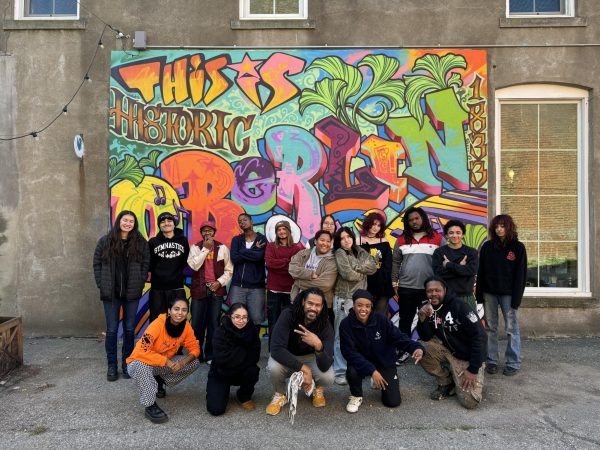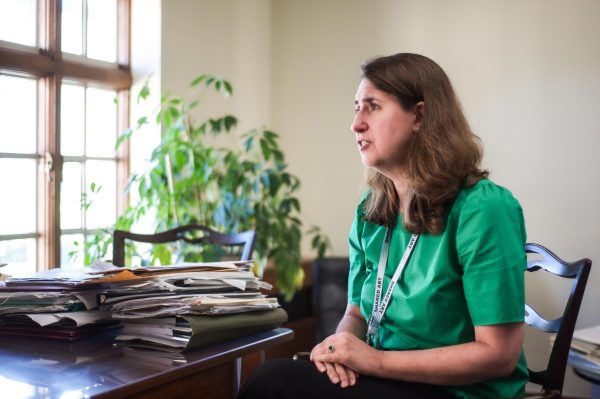The Body Behind the Art: Figure Models Discuss The Job
Walking through an art museum, it’s easy to find the names of the artists whose work hangs on the walls, but it’s rare that a museum-goer can name the models depicted in the artwork. Figure models serve as muses for artists, visual references that both the creator and the viewer appreciate, but these models are rarely given credit for their work. This is especially true for women of color, who have historically been misrepresented by white, male artists.
In the Oberlin art community, figure models are often Oberlin students modeling for their peers in Studio Art classes. Some of these students also model for community classes at the Firelands Association for the Visual Arts. There are still racialized and gendered power dynamics at play in the studio art classroom, but many models describe a positive work environment.
“It’s so funny, I look up and I see that everyone’s still watching me, and I kind of forget why everyone’s looking at me,” said College fourth-year Peri Levin about her experience as a figure model for an Oberlin art class.
As an Art History major, Levin explained that she was interested in figure modeling because it allowed her to understand the studio side of the Art department better, and she also appreciated the high pay rates. For many students, modeling is just a campus job albeit a strange one.
“It’s refreshing to walk into a situation and know exactly what you have to do and be able to do it,” said College second-year Claire Daily. “Every night it’s the same: You do 10 x 30-second poses, and then a standing pose, and then a sitting pose, and then three lying-down poses for longer periods of time. So it becomes very easy after a while. … It’s kind of relaxing.”
However, Daily explains that modeling can become physically uncomfortable. Levin shared Daily’s sentiment that holding poses for long amounts of time can be painful, but she added that the students and professors in her classes are understanding when she needs to take a break or change poses.
“I don’t know if people can ever tell when I’m in pain,” Levin said. “I imagine they kind of can, but I think I also … go to a different place in my head and find a certain grace or calmness because that’s just part of what it is; your hands fall asleep, and your feet fall asleep, and it hurts.”
Because of the uncomfortable and vulnerable nature of the job, it’s important that professors create a safe space for their models. College fourth-year Jack Spector-Bishop, who has been modeling for three years, said that Visiting Assistant Professor of Art Mimi Kato is particularly kind to her models, which Spector-Bishop attributes to Kato’s own experience as a model.
“I feel like people who have modeled just understand how it’s just such a weird scenario when someone who is theoretically your employer is asking you to do things that are physically difficult with your body,” said Spector-Bishop.
Another strange aspect of the job, of course, is the final product. After posing for a class, the models are able to see many versions of themselves through different artistic lenses.
“I like to think of it as like the pre-modern version of when you take 20 selfies at one time and then you would go through them to see which one is good,” Spector-Bishop said.
Some might find this unsettling, but Levin has learned to love the artwork.
“I don’t even care when I don’t feel like I look attractive in the images,” said Levin. “Whether or not it’s because I just don’t think it looks like me, or because I think it does look like me and I don’t like what [that] looks like necessarily, I still love them.”
Other models are interested in the way that artists see their bodies.
“It’s really neat to sort of see [and] think about how I see my face versus how someone else sees my face,” Daily said.
However, seeing your body depicted by others can lead to some frustrating and uncomfortable moments. Nearly all of the Oberlin models are white, assigned female at birth, and thin. College fourth-year and figure model Lyala Khan said that, because the artists in her class are mostly white, as are the models they have previously used, the students often create a very distorted version of her body.
“Most of the time, people will try to make me look skinnier than I am and also lighter,” Khan said. “And some of that is probably just plain racism, but a lot of it is also a fear of being racist and therefore representing me as a race-less, unidentifiable person as opposed to something that they think I would think is wrong.”
Khan explained that, whether it be at the FAVA or in the Oberlin classroom, white artists are often confused about painting non-white skin tones.
“A professor once told me that they had an incident in a class where a student literally had never used a non-white person as a model and was confused,” said Khan. “Even with white people, it’s not white paint. You need pink or whatever to get that fleshy color. But when you put [in] a little melanin,people get confused.”
It’s clear that studio classes need to hire more models of color and a diversity of body types. Professors must push white students to accurately draw or paint the figure in front of them regardless of the model’s race, but Khan explained that a white professor she worked with had racial biases of her own. Khan recalled that this white professor attempted to depict her in an exoticized manner.
“[One professor] asked me to actively perform diversity in the classroom,” Khan said. “She said to bring things from my culture. She asked me if I was a dancer and … [if I] could pose in dance form, to which I said no. … I assume that she wanted me to do some exotic pose.”
It’s unacceptable for art professors to remain ignorant to the power dynamics between white artists and female models of color. Levin spoke to this issue from a historical context.
“There is such a history of, for example, artists going to colonial spaces and using indigenous women in their art and completely not giving them any credit,” she said.
Khan said her experience modeling has been “interesting” rather than simply uncomfortable. She attributes these positive feelings to her work with former Oberlin professor Jean Kondo Weigl, who was Khan’s first boss and also a woman of color.
Still, Khan feels that everyone should recognize the model’s humanity.
“The only generalization that I can make is that people do dehumanize the model,” Khan said. “I think that sometimes it’s in an effort to show respect. … But at other times, it also feels dehumanizing, … especially when you’re lying there and you have nothing to do but look directly at the students, and they’re looking at your body and not really at you.”
Whether it’s a famous painting at Allen Memorial Art Museum or a student’s figure drawing at Oberlin College’s Art Walk, the models behind the artwork deserve recognition for their hard work and vulnerability.







